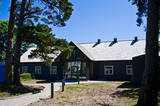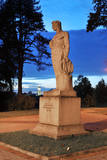| Нo | Название | Описание |
|---|---|---|
|
Предлагают процесс рыбной ловли с вытягиванием невода на Нидском и Папском взморье, рыбалку в море (для 1 - 2 человек) и рыбалку зимой. После рыбной ловли следует копчение улова или приготовление ухи. |
||
|
Atrodas Inciema centrā. Piedāvā maltīti visām ēdienreizēm. Lielas porcijas, garšīgs ēdiens. Iecienīta tuvākas un plašākas apkaimes maltītes ieturēšanas vieta. Klāj galdus. |
||
|
Восстановительные грязевые пруды
это место, где депонируются использованные
курортным и реабилитационным центром
"Яункемери" грязи.
|
||
|
The owners have made sure that everyone can buy fresh and processed fishery products from local producers. During the summer, on the terrace, you can listen to Mazupīte's water, enjoy freshly grilled fish, as well as enjoy particularly delicious cakes, coffee and ice cream. |
||
|
"Лайкас" полюбили прибрежные рыболовы Балтийского моря. В качестве улова можно поймать камбалу, треску или угря. Хозяева варят вкусную уху из морской рыбы, а также коптят рыбу. Приехавшие сюда могут принять участие в процессе приготовления рыбы. |
||
|
Livonian Community House at Kolka was opened in 2019. It is a place where you can get to know the Livonian culture of Northern Kurzeme, learn about traditional activities, listen to the sound of the language, and get an idea of the cultural and historical heritage of the coast. In House you can organize and attend cultural events, seminars, trainings, exhibitions, and also receive tourism information. |
||
|
Хозяйство «Йокас» находится 4 км восточнее Турлавы. Хозяин Янис Узуленс целенаправленно развивал и расширял предприятие начиная с его основания в 2011 году. Гордость хозяйства – стадо крупного рогатого скота мясной породы, в котором около 70 коров, а также пять лошадей. В хозяйстве производят колбасы и другую мясную продукцию. Хозяйство предлагает и другие услуги – обслуживание леса и рыбоводство. |
||
|
Die älteste (16 Jh.) der drei Burge am Fluss Nemunas. Renoviert nach dem 2. Weltkrieg. Heutzutage – eine Schule. Ein Park. Blick vom Burgturm. |
||
|
Кафе в центре Саулкрасты. Предлагаются не только кондитерские изделия, но и теплые блюда. Среди жителей и гостей города Саулкрасты популярностью пользуются кебабы в латышском вкусе. В кафе имеются стульчики для малышей. Время работы: летом с 8:00 до 20:00, с сентября по май с 8:00 до 18:00. |
||
|
Берегом ливов сегодня именуется ряд прибрежных поселков от Овиши до Гипки вдоль берегов Балтийского моря и Рижского залива. Ливы, также как и латыши, – один из коренных народов Латвии, предки которых проживали в этих краях более чем 5000 лет тому назад. Они проживали на обширных землях сегодняшней территории Латвии в Курземе и в Видземе. Дольше всего ливы проживали на побережье Балтийского моря – В северном Курземе. На берегу ливов все еще можно встретить настоящих ливских рыбаков, почувствовать запах копченой рыбы, отведать традиционные блюда, осмотреть разные виды заборов, ощутить сдержанный шарм рыбацких поселков, понаблюдать за встречей двух морей, птиц и людей в Колкасраге, услышать ливский диалект латышского языка, увидеть круглые спины дюн (кангаров) и болотистые кривые впадины (виги) между ними, увидеть маяк Шлитере, зелено-бело-синий флаг ливов, красные ягоды клюквы, пути перелетных птиц и синих коров. С древнейшими свидетельствами ливов можно ознакомиться в Центрах ливов. Сегодня дух ливов живет в названиях мест, изделиях ручной работы, в национальных костюмах, в восприятии мира и стиле жизни местных жителей. Ливский язык и культурные ценности включены в состав Латвийского национального культурного наследия. Традиционная культура ливов входит в латвийский культурный канон. |
||
|
Находится в центре поселка Цибла. Центральной доминантой Эверсмуйжи является господский дом, построенный в 1680-м году в стиле классицизма (перестроен в более поздние времена), дом для слуг, превратное здание и хозяйственные постройки, находящиеся в плохом состоянии. Парк имения окружен каменным забором. Начиная с 17-го века имение почти два столетия принадлежало роду польских баронов Карницких. Позже в имении сменяются хозяева. В наши дни в господском доме расположен Циблский интернат, размещен Циблский краеведческий музей, где предлагают экскурсии. По берегам речки Илжа пролегает Эвермуйжская культурно-историческая тропа. |
||
|
Отдаленное место почти у самой латвийско-литовской границы, в 5 км юго-западнее от Нерете, куда непременно следует отправиться любителям истории. Почему? Одна из причин - это то, что сушилка (понемногу восстанавливается) и печь для сушки зерна (часть старых деревянных частей еще сохранилась) поместья являются единственными в Латвии. Из комплекса господской усадьбы осталась конюшня и дом для прислуги, в котором живут и сегодня. Здания построены в 18 веке. Хозяин любит рассказывать интересные случаи, связанные с историей этого места. |
||
|
Часть связи в Книпупьи в Бартских лесах брошена и является бесхозной. Деградирующий объект, здания демонтированы с целью получения строительных материалов.
|
||
|
Ļoti ainavisks ezers, uz kuru paveras lieliskas ainas no Vidzemes augstienes pauguriem. Te jāatceras latviešu teika par Ineša un Alauksta strīdu, kā rezultātā Inesis dabūja pliķus – salas, kurām (sešām) tāpat kā Sproģu pussalai ir dabas lieguma statuss. |
||
|
В XV столетии господская усадьба Прейли становится родовым имением графов Борхов. Борхи хозяйствовали здесь до 60-х годов XIX века. Сам город образовался в первой половине XIX века при сливании имения Прейли с селением и слободой - поселением ремесленников и торговцев. В XIX веке в Прейли построили роскошный дворец и разбили ландшафтный парк. Современный город Прейли – это важный экономический центр Латгалии (сырное и швейное производство), который бережно относится к своему фольклору, традициям ремесленничества и католицизма. По Прейли настоятельно рекомендуется экскурсия в сопровождении сотрудника ИЦТ Ирены Кяркужи. |
||
|
Моленная Речинской старообрядческой общиныпостроена в 1912 году. Четырехугольное здание
одного холла с каменным фундаментом и невысокой башенкой. Главный вход в боковой стороне
фасада.
|
||
|
Созданный скульптором Карлисом Земдегой, установленный в 1939-м году, памятник посвящен министру земледелия Латвийской Республики Артурсу Альберингу. Памятник представляет собой юношу с севалкой. В советское время памятник исчез и на его месте установили пионера из гипса. В 1977-м году дети нашли в земле закопанные части «Сеятеля», а через 10 лет, в речке Руя, его голову. Теперь восстановленный памятник находится на своем историческом месте – в парке Тернеяс возле ул. Ригас. |
||
|
Saimniecības laukos ganās ap 300 aitu kupls ganāmpulks, no kura iegūst gaļu un vilnu. Piedāvā ekskursiju, kurā stāsta par aitu audzēšanu, cep maizi, auž un uz ugunskura vāra zupu. Apmeklētāji var iegādāties adītas zeķes, cimdus, segas, lakatus, galdautus un citas saimniecībā noderīgas lietas. Stāsta par atjaunotās mājas vēsturi un kopj latviskās tradīcijas. |
||
|
Находится в Лаши, в 0,2 км от дороги Вецумниеки – Илуксте. Древнее городище селов, заселенное с первоготысячелетиядорождестваХристова до 10 - 12 столетия. В наши дни в городище видны ничтожные остатки комплекса бывшей Вецлашской (Тизенхаузенов) господской усадьбы (внушительный господский дом был построен в конце 19 века в неоготическом стиле), из которого сохранилось хозяйственное строение, фундамент господского дома, фрагменты ворот и парк. До 1920 года господская усадьба принадлежала роду графов Пшездзецких (перед этим - Тизенхаузенам, Фитингхоффам). Перед тем, как отправляться к этому месту, в Интернете стоит найти старинные фотоснимки господского дома. К сожалению, в течение последних 20 лет этот памятник культуры не пережил каких-то значительных работ по благоустройству. |
||
|
Piedāvājumā relaksācija pirtī - sildīšanās, skrubēšanās, enerģiskais pēriens, kā arī dažādas masāžas. |
||







.jpg?size=160)














